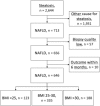Risk for development of severe liver disease in lean patients with nonalcoholic fatty liver disease: A long-term follow-up study
- PMID: 29404512
- PMCID: PMC5776871
- DOI: 10.1002/hep4.1124
Risk for development of severe liver disease in lean patients with nonalcoholic fatty liver disease: A long-term follow-up study
Abstract
Most patients with nonalcoholic fatty liver disease (NAFLD) are overweight or obese. However, a significant proportion of patients have a normal body mass index (BMI), denoted as lean NAFLD. The long-term prognosis of lean NAFLD is unclear. We conducted a cohort study of 646 patients with biopsy-proven NAFLD. Patients were defined as lean (BMI < 25.0), overweight (BMI 25.0-29.9), or obese (BMI ≥ 30.0) at the time of biopsy. Each case was matched for age, sex, and municipality to 10 controls. Overall mortality and development of severe liver disease were evaluated using population-based registers. Cox regression models adjusted for age, sex, type 2 diabetes, and fibrosis stage were used to examine the long-term risk of mortality and liver-related events in lean and nonlean NAFLD. Lean NAFLD was seen in 19% of patients, while 52% were overweight and 29% were obese. Patients with lean NAFLD were older, had lower transaminases, lower stages of fibrosis, and lower prevalence of nonalcoholic steatohepatitis at baseline compared to patients with a higher BMI. During a mean follow-up of 19.9 years (range 0.4-40 years) representing 12,631 person years and compared to patients who were overweight, patients with lean NAFLD had no increased risk for overall mortality (hazard ratio 1.06; P = 0.73) while an increased risk for development of severe liver disease was found (hazard ratio 2.69; P = 0.007). Conclusion: Although patients with lean NAFLD have lower stages of fibrosis, they are at higher risk for development of severe liver disease compared to patients with NAFLD and a higher BMI, independent of available confounders. (Hepatology Communications 2018;2:48-57).
Figures
References
-
- Younossi ZM, Stepanova M, Afendy M, Fang Y, Younossi Y, Mir H, et al. Changes in the prevalence of the most common causes of chronic liver diseases in the United States from 1988 to 2008. Clin Gastroenterol Hepatol 2011;9:524‐530.e1. - PubMed
-
- Loomba R, Sanyal AJ. The global NAFLD epidemic. Nat Rev Gastroenterol Hepatol 2013;10:686‐690. - PubMed
-
- Younossi ZM, Koenig AB, Abdelatif D, Fazel Y, Henry L, Wymer M. Global epidemiology of nonalcoholic fatty liver disease‐meta‐analytic assessment of prevalence, incidence, and outcomes. Hepatology 2016;64:73‐84. - PubMed
LinkOut - more resources
Full Text Sources
Other Literature Sources




